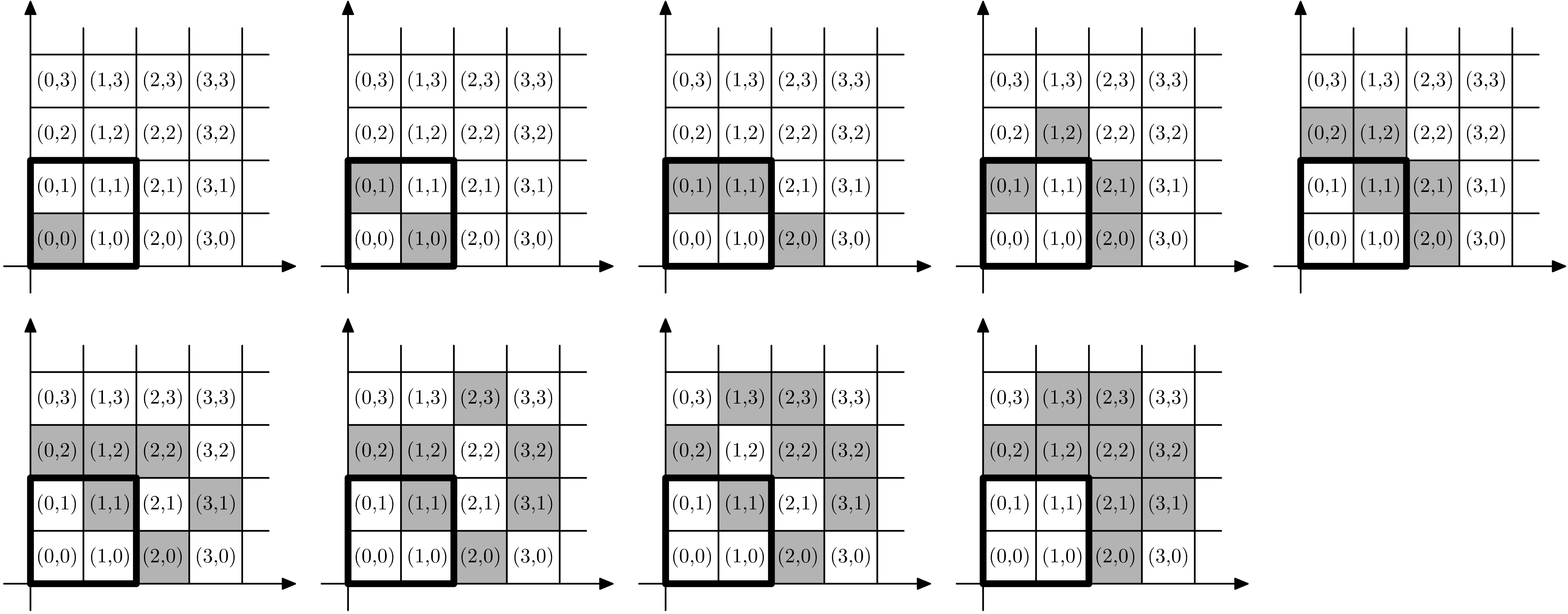A newly discovered organism can be represented as a set of cells on an infinite grid. There is a coordinate system on the grid such that each cell has two integer coordinates $$$x$$$ and $$$y$$$. A cell with coordinates $$$x=a$$$ and $$$y=b$$$ will be denoted as $$$(a, b)$$$.
Initially, the organism consists of a single cell $$$(0, 0)$$$. Then zero or more divisions can happen. In one division, a cell $$$(a, b)$$$ is removed and replaced by two cells $$$(a+1, b)$$$ and $$$(a, b+1)$$$.
For example, after the first division, the organism always consists of two cells $$$(1, 0)$$$ and $$$(0, 1)$$$, and after the second division, it is either the three cells $$$(2, 0)$$$, $$$(1, 1)$$$ and $$$(0, 1)$$$, or the three cells $$$(1, 0)$$$, $$$(1, 1)$$$ and $$$(0, 2)$$$.
A division of a cell $$$(a, b)$$$ can only happen if the cells $$$(a+1, b)$$$ and $$$(a, b+1)$$$ are not yet part of the organism. For example, the cell $$$(1, 0)$$$ cannot divide if the organism currently consists of the three cells $$$(1, 0)$$$, $$$(1, 1)$$$ and $$$(0, 2)$$$, since the cell $$$(1, 1)$$$ that would be one of the results of this division is already part of the organism.
You are given a set of forbidden cells $$${(c_i, d_i)}$$$. Is it possible for the organism to contain none of those cells after zero or more divisions?
Each test contains multiple test cases. The first line contains an integer $$$t$$$ ($$$1 \le t \le 10\,000$$$) — the number of test cases. The descriptions of the $$$t$$$ test cases follow.
The first line of each test case contains an integer $$$n$$$ ($$$1 \le n \le 10^6$$$) — the number of forbidden cells.
The next $$$n$$$ lines contain two integers each. The $$$i$$$-th of such lines contains $$$c_i$$$ and $$$d_i$$$ ($$$0 \le c_i, d_i \le 10^9$$$) — the coordinates of the $$$i$$$-th forbidden cell. It is guaranteed that all forbidden cells are distinct.
It is guaranteed that the sum of values of $$$n$$$ over all test cases does not exceed $$$10^6$$$.
For each test case, print $$$\texttt{YES}$$$ if it is possible for the organism to contain no forbidden cells after zero or more divisions. Otherwise, print $$$\texttt{NO}$$$.
240 01 00 11 1160 00 10 20 31 01 11 21 32 02 12 22 33 03 13 23 3
YES NO
In the first test case, dividing the following cells in the following order creates an organism without any forbidden cells: $$$(0, 0)$$$, $$$(1, 0)$$$, $$$(1, 1)$$$, $$$(0, 1)$$$, $$$(2, 1)$$$, $$$(2, 2)$$$, $$$(1, 2)$$$, $$$(1, 1)$$$. The following picture demonstrates how the organism changes during this process:

In the second test case, you can see that, surprisingly, any organism always has at least one cell in the $$$0 \le x, y \le 3$$$ square, no matter how many divisions we do.
| Название |
|---|




